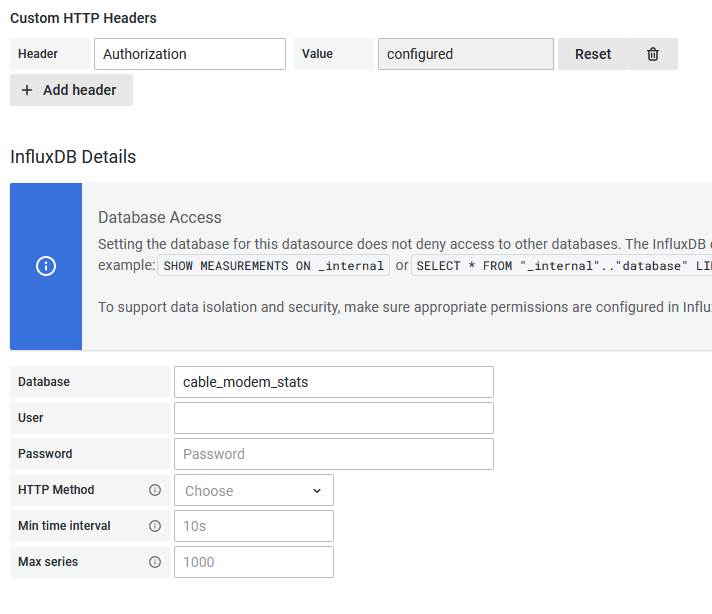This is a Python script to scrape stats from the Arris SB8200, Arris S33, Arris S34, and Comcast XB8 cable modem web interface. Results are meant to be sent to InfluxDB 2.x for use with Grafana, but other targets could be added.
This project is based off of:
- https://github.com/andrewfraley/arris_cable_modem_stats
- https://github.com/billimek/SB6183-stats-for-influxdb
- https://github.com/t-mart/ispee
Set modem_model to xb8. There are no special config options for this modem. Set modem_password in the config with your modem password.
Set modem_model to s33 (currently the default). There are no special config options for this modem. Set modem_password in the config with your modem password.
If modem uses SSL, set modem_ssl to true.
In late Oct 2020, Comcast deployed firmware updates to the SB8200 which now require authenticating against the modem. If your modem requires authentication (you get a login page when browsing to https://192.168.100.1/), then you must edit your config.ini file (or set the matching ENV variables) and set modem_auth_required to True, and set modem_password appropriately. By default, your modem's password is the last eight characters of the serial number, located on a sticker on the bottom of the modem.
There is some kind of bug (at least with Comcast's firmware) where the modem cannot handle more than ~10 sessions. Once those sessions have been used up, it seems you must wait for them to expire or reboot the modem. I have not been able to successfully log out of the sessions, but this script attempts to keep reusing the same session as long as it can.
In Sept 2021, Comcast deployed another firmware which changed the login flow. If you have firmware version AB01.02.053.05_051921_193.0A.NSH or higher, please set modem_new_auth to True.
This version seems to fix the ~10 session limit from the Oct. 2020 fimware. The sleep_interval has been reduced from 300 to 120.
Docker Compose file
version: '3'
services:
arris_stats:
image: ghcr.io/sarabveer/arris_cable_modem_stats:latest
container_name: arris_stats
restart: unless-stopped
network_mode: host
environment:
- modem_password=PutPasswordHereNote that the same parameters from config.ini can be set as environment variables. The environment variables override anything set in config.ini.
-
Install the latest Python 3
-
Clone repo
-
Change directory
$ cd cable-modem-stats
-
Install virtualenv
$ python3 -m pip install virtualenv
-
Create and activate virtualenv
$ python3 -m venv venv$ source venv/bin/activate
-
Install pip dependencies
python3 -m pip install -r src/requirements.txt
-
Edit config.ini and set the approriate settings
-
If your cable modem requires authentication, edit config.ini and set:
modem_password = <your-password>- Check Authentication for specific options for your modem model
-
Run arris_stats.py
python3 src --config config.ini
Config settings can be provided by the config.ini file, or set as environment variables. Environment variables override config.ini. This is useful when running in a Docker container.
| Option | Default | Notes |
|---|---|---|
modem_model |
s33 | Pick either s33, sb8200, or xb8 |
exit_on_auth_error |
True |
Any auth error will cause an exit, useful when running in a Docker container to get a new session |
exit_on_html_error |
True |
Any error retrieving tdata will cause an exit, mostly redundant with exit_on_auth_error |
clear_auth_token_on_html_error |
True |
This is useful if you don't want to exit, but do want to get a new session if/when getting the stats fails |
sleep_before_exit |
True |
If you want to sleep before exiting on errors, useful for Docker container when you have restart = always |
request_timeout |
30 |
Seconds to wait before request to fetch modem webpage/data times out |
| Option | Default | Notes |
|---|---|---|
influx_url |
http://localhost:8086 |
InfluxDB URL |
influx_bucket |
cable_modem_stats |
DBRP Name |
influx_org |
Org ID | |
influx_token |
Token | |
influx_verify_ssl |
True |
Verify SSL cert when connecting to InfluxDB |
You can enable debug logs in three ways:
- Use --debug when running from cli
pipenv run python3 src --debug --config config.ini
- Set ENV variable
arris_stats_debug = trueor config.inienable_debug = true
The Grafana dashboard uses InfluxQL, so a DBRP mapping needs to be made:
influx v1 dbrp create \
--db cable_modem_stats \
--rp cable_modem_stats \
--bucket-id <bucket-id> \
--defaultReplace <bucket-id> with the ID of the cable_modem_stats bucket created in InfluxDB 2.x
Read more about this here
In order to add the InfluxDB data source to Grafana, a DBRP has to be created (as shown above), and then the data source has to be setup as shown below:
The Authorization header has to be in format: Token <your-token-here>
Read more about this here.
- Setup arrris_stats.py to run from somewhere
- Import a new dashboard using the grafana/sb8200_grafana.json file. Originally exported from Grafana v8.0.5


